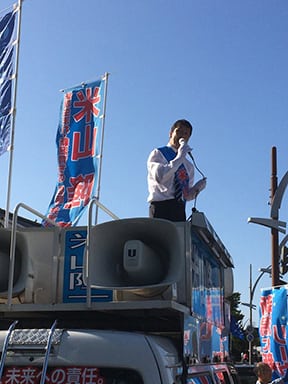Election Result Throws Restart of World’s Largest Nuclear Plant into Question
A surprising win in a Japanese prefectural gubernatorial race by the anti-nuclear, Communist Party–backed candidate Ryuichi Yoneyama—a 49-year-old doctor who has never held public office—makes the restart of the 8-GW Kashiwazaki-Kariwa nuclear plant a much taller task for owner Tokyo Electric Power Co. (TEPCO).
The election of Yoneyama (Figure 1) is also a setback for Prime Minister Shinzo Abe’s energy policy. Polls had shown Yoneyama trailing Tamio Mori—the candidate endorsed by Abe’s Liberal Democratic Party—in the Niigata Prefecture gubernatorial race, but concerns over the future of the seven-reactor complex appear to have swung the vote in Yoneyama’s favor.
 |
1. Niigata Prefecture’s newly elected governor. The anti-nuclear Ryuichi Yoneyama is shown here campaigning the day before the election. Courtesy: Ryuichi Yoneyama |
“Under current circumstances where we can’t protect the lives and the way of life of citizens in the prefecture, I can’t approve a restart,” Yoneyama was quoted by The Japan Times as telling reporters on October 17 in reference to the Kashiwazaki-Kariwa reactors.
TEPCO, which has faced economic troubles following the well-known disaster at its Fukushima Daiichi facility, recently claimed that the restart of its Kashiwazaki-Kariwa reactors is critical to keeping the company solvent. But the Kashiwazaki-Kariwa site (the largest nuclear generating station in the world in terms of capacity) is no stranger to earthquakes, the likes of which led to the Fukushima meltdown.
In November 2004, seismic detectors at the plant recorded tremors from the Chūetsu earthquake, although all operating units remained online. However, in July 2007, Kashiwazaki-Kariwa was completely shut down after the Chūetsu Offshore earthquake—a 6.6-magnitude event with an epicenter roughly 12 miles from the facility—reportedly shook the plant beyond its design basis. All units were offline for more than 21 months to complete earthquake-proofing upgrades. Four of the units had been returned to service before the Fukushima accident in March 2011 forced them all back offline again.
The election result shows that anti-nuclear sentiment continues to spread throughout Japan. On July 10, Satoshi Mitazono—a journalist—defeated incumbent Gov. Yuichiro Ito in Kagoshima Prefecture after campaigning on a promise to shut down operations at the two-unit Sendai nuclear plant. Sendai was the first Japanese reactor to restart after Fukushima, returning to operations last year after months of litigation and uncertainty.
In late August, Mitazono urged Sendai-owner Kyushu Electric Power Co. to suspend operation of the facility. Although Sendai Unit 1 was taken offline on October 6, all indications are that the plant will return to service following what is expected to be a two-month scheduled inspection.
—Aaron Larson, associate editor (@AaronL_Power, @POWERmagazine)